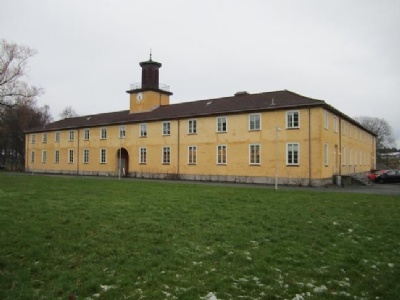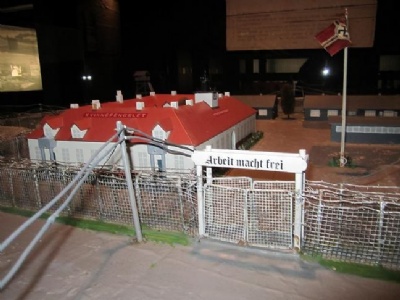Falstad
About sixty kilometres north of Trondheim lies a small community called Ekne where a municipal boarding school hand been since 1921. In August 1941, the SS searched for a place in the region (Tröndelagen) to set up a camp and found the former school suitable for the purpose. Falstad became one of the six camps that were placed under the German Security Police (SIPO) and the Security Service (SD) in Norway. However, unlike the other five that were named Polizeihäflingslager, Falstad was called Strafgefangenlager. The camp was subordinated to the regional SIPO headquarters in Trondheim under the leadership of SS-Obersturmbannführer Gerhard Flesch. The first prisoners arrived in November 1941 when 170 Danish political prisoners arrived and were forced to prepare the camp by setting up barbed wire and building watchtowers around the school. The prisoners were divided into labour commands and forced to work both inside and outside the camp with various tasks.
The camp also served as a transit camp for prisoners on their way either to/from northern or southern Norway. The first Jews were incarcerated as early as December 1941, and from the spring of 1942 they were separated from other prisoners. During October and November 1942, Falstad also served as a transit camp for Jews arrested in the region. From Falstad they were then deported to prisons in Oslo and then on by boat to Eastern Europe. A total of 48 Jews were imprisoned in Falstad, eight of them were executed in the camp, but most were deported. Until the autumn of 1943, the prisoners were incarcerated in different parts of the school. There were about thirty prison cells, smaller workshops, offices and kitchens. The school’s courtyard served as the appellplatz (assembly square). In the autumn of 1943, the number of prisoners had risen to almost 500 and the camp command decided to expand the camp with several barracks around the main building (school).
On October 6, 1942, German reich commissioner, Josef Terboven, declared a state of emergency in large parts of the region of Tröndedal as a consequence of sabotage actions carried out by the resistance movement. Within a few days, 34 people were executed in Falstad forest about a kilometer outside the camp. During 1942 and 1943, between 200 – 300 prisoners were shot in Falstad Forest, some of them came from Falstad while others came elsewhere. Most of the victims were Soviet prisoners of war and yugoslav prisoners. Exactly how many people were killed in the forest is not known. Falstad was the only Polizeihäflingslager in Norway with its own execution site. At the end of the war, the Germans tried to remove the evidence in the forest. 25 bodies were dug up, put on a boat, which the germans sunked in Trondheim fjord. The boat has never been found.
After the war 46 graves were located in forest with at least one body. The bodies were later taken to Trondheim for identification and then buried in Trondheim Cathedral Cemetery. Only about half of the bodies were identified. Not all graves have been discovered. A total of about 4,500 prisoners from 13 nations were imprisoned at Falstad between November 1941 and the liberation in May 1945. Only Grini in Oslo had a larger number of prisoners. Between 1945 and 1951 the camp was used as a prison for Norwegian collaborators and between 1951 and 1991 as a school. Of the barracks built outside the main building, all but one were demolished.
Current status: Partly preserved/demolished with museum (2011).
Address: Falstadvegen 59, 7624 Ekne.
Get there: Car.
Follow up in books: Kogon, Eugen: The Theory and Practice of Hell: The German Concentration Camps and the System Behind Them (2006).







On basement level of the main building there is a permanent exhibition well worth a visit. Occasionally there are temporary exhibitions. There is also a library and study and the museum offers courses and lectures for those who wish. Falstad is very reminiscent of the Wannsee museum in Berlin, but with the difference that everything is much bigger in Wannsee. The information in Falstad is interspersed with photographs and moving images that make the exhibition well balanced. The down side is its location on the countryside which makes it difficault to visit without a car.